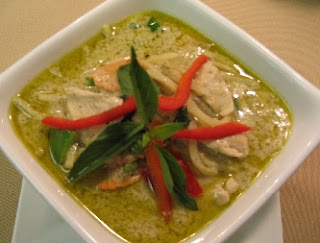 Chili(Prik) is the main spices of Thai foods seasoning that make the tasteless of food become spice up and tasteful.
Chili(Prik) is the main spices of Thai foods seasoning that make the tasteless of food become spice up and tasteful.Chili is one of spices which important for Thai cuisine for long time. Every meal always has chili that seem it cannot separated from Thai foods so every household will keep it as dried chili, chili powder and fresh chili.
Now, I make you known to chili which often use in Thai Foods.
1. Bird chili (Prik Ki Noo)
It has both green and red everyone give a nickname to it “bantam chili” because of its small shape but very very hot and spicy. Do you believe superman can cry!!. Bird chili often put to papaya salad (Som Tam) and sometime put it on side dishes with sago ( Sa Koo Sai Moo).
2. Dried chili (Prik Hang)
Dry chili is bird chili that dried by the sun, it has good smell and proper to make chili sauce and put it on side dishes with Thai rice noodle. Sometimes we spinning it as chili powder and use it for season in noodle.
3. Sweet chili (Prik Whan)
Sweet chili or jumbo chili, like its shape. It has 3 color ; green, red and yellow. Taste of sweet chili is little spicy so we often eat with vegetable salad or fried it like tempura. With the colorful of it, make it more appetizing.
4. Large chili (Prik Chee Fah)
Large chili has native land in tropical area of America, its shape round-long and sharp tail. It has many colors ; green, red and orange. We often use it in fired rice because it has little spicy and sometimes we grill it for make chili sauce, it has good smell. Before use it should core its seed.
 In Northeast Thailand(Isaan), Rice Noodle with Catfish Curry is not commonly sold in noodle shops! Instead. Kanom Jeen Nam Ya is most famous food of
In Northeast Thailand(Isaan), Rice Noodle with Catfish Curry is not commonly sold in noodle shops! Instead. Kanom Jeen Nam Ya is most famous food of  This is a green curry made with minced chicken and small green aubergine. Chicken Green Curry is popular foods in
This is a green curry made with minced chicken and small green aubergine. Chicken Green Curry is popular foods in  Pad Thai is the one of
Pad Thai is the one of This is a traditional Isan [North East
This is a traditional Isan [North East 
